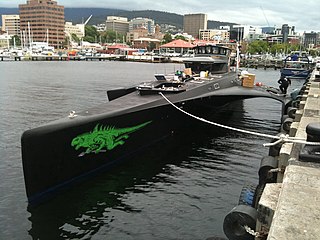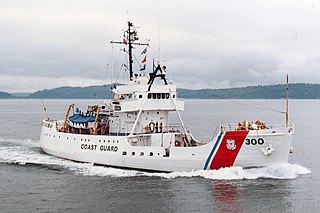
The Sea Shepherd Conservation Society (SSCS) is a non-profit, marine conservation activism organization based in Friday Harbor on San Juan Island, Washington, in the United States. Sea Shepherd employs direct action tactics to achieve its goals, most famously by deploying its fleet of ships to track, report on and actively impede the work of fishing vessels believed to be engaged in illegal and unregulated activities causing the unsustainable exploitation of marine life.

RV Farley Mowat was a long-range, ice class ship. Originally built as a Norwegian fisheries research and enforcement vessel, she was purchased by the Sea Shepherd Conservation Society in Edinburgh, Scotland, in August 1996. Originally named Sea Shepherd III, the name was changed in 1999 to Ocean Warrior, before eventually being renamed in 2002 after Canadian writer Farley Mowat.

The Island-class patrol boat is a class of cutters of the United States Coast Guard. 49 cutters of the class were built, of which 37 remain in commission. Their hull numbers are WPB-1301 through WPB-1349.

USCGC Douglas Munro (WHEC-724), previously USCGC Munro (WHEC-724), is a Hamilton-class High Endurance Cutter of the United States Coast Guard, named for Signalman First Class Douglas A. Munro (1919–1942), the only Coast Guardsman to be awarded the Medal of Honor.

Neptune's Navy is the name that the Sea Shepherd Conservation Society uses to refer to the ships it operates. Most of these vessels are used to disrupt or hinder fishing, whaling or sealing operations that the group considers illegal.

USCGC Boutwell (WHEC-719) was a United States Coast Guard high endurance cutter based out of San Diego, California. Named for George S. Boutwell, United States Secretary of the Treasury under President Ulysses S. Grant. Boutwell engaged in many Coast Guard missions, including search and rescue, law enforcement, maritime security, and national defense.

USCGC Rush (WHEC-723) was a United States Coast Guard high endurance Hamilton-class cutter. The ship was named after Secretary of the Treasury Richard Rush. Rush was launched on November 16, 1968, commissioned on July 3, 1969, and was decommissioned on February 3, 2015 after 45 years of Coast Guard service.

USS Barbican (ACM-5) was a Chimo-class minelayer in the United States Navy. Barbican was later commissioned in U.S. Coast Guard as USCGC Ivy.

The MV Steve Irwin was the 59-metre (194 ft) flagship of the Sea Shepherd Conservation Society, and was used in their direct action campaigns against whaling and against illegal fisheries activities. The vessel was built in 1975 and formerly served as a Scottish Fisheries Protection Agency conservation enforcement patrol boat, the FPV Westra, for 28 years.

MV Brigitte Bardot is a unique high-tech 35 m (115 ft) stabilized monohull twin diesel engine powered vessel designed by Nigel Irens. Construction of the vessel began in June 1997 and she was launched on 16 March 1998. The official naming ceremony took place on 3 April 1998 in London's West India Dock. In 2021, the vessel was sold to a private owner.
Canada's 2008 annual commercial seal hunt in the Gulf of St. Lawrence and around Newfoundland, Quebec and Nova Scotia began on March 28. The hunting season lasts from mid-November to mid-May, but the hunt mainly occurs in March and April. Canada's seal hunt is the world's largest hunt for marine mammals.

The Ukrainian patrol vessel Sloviansk (P190) was an Island-class patrol boat of the Naval Forces of Armed Forces of Ukraine. Originally named USCGC Cushing when in service with the United States Coast Guard, the vessel was acquired by Ukraine in 2018.

USCGC Citrus (WAGL-300/WLB-300/WMEC-300) was a Cactus (A)-class seagoing buoy tender built in 1942 in Duluth, Minnesota, and now operated by the navy of the Dominican Republic.

The Sea Shepherd Conservation Society engages in various demonstrations, campaigns, and tactical operations at sea and elsewhere, including conventional protests and direct actions to protect marine wildlife. Sea Shepherd operations have included interdiction against commercial fishing, shark poaching and finning, seal hunting and whaling. Many of their activities have been called piracy or terrorism by their targets and by the ICRW. Sea Shepherd says that they have taken more than 4,000 volunteers on operations over a period of 30 years.
USCGC Tupelo WAGL/WLB-303, was a Cactus (A) Class 180-foot buoy tender vessel built by Zenith Dredge Company of Duluth, Minnesota. Her keel was laid 15 August 1942, launched 28 November 1942 and commissioned on 30 August 1943. She was built as a WAGL and redesignated a WLB in 1965.

At the Edge of the World is a 2008 documentary which chronicles the efforts of animal rights activist Paul Watson and 45 other volunteers, who set out in two Sea Shepherd ships to hinder the Japanese whaling fleet in the waters around Antarctica. The film won Best Environmental Film at the Vancouver International Film Festival. Director and Producer Dan Stone would later produce the first season of Whale Wars. It depicts what actually went on during this excursion, with clips of beautiful scenery, news clips, whaling in action, and life on the ship.
The Kaikō Maru was the spotter ship for the Japanese whaling fleet. In 2007, it collided with the Sea Shepherd Conservation Society vessel MY Robert Hunter and was disabled. It sent out a mayday and the Robert Hunter, Farley Mowat, and the Esperanza were obliged to respond until the Kaiko Maru was repaired.

Eco-Pirate: The Story of Paul Watson is a 2011 documentary film directed by Trish Dolman and produced by Kevin Eastwood. It follows radical conservationist Paul Watson during anti-whaling campaigns in the Antarctic in 2009 and 2010, and recounts his history and controversial methods as an activist and media personality. It premiered May 1, 2011 at the Hot Docs Documentary Film Festival.

MV John Paul DeJoria was a cutter class vessel owned and operated by the Sea Shepherd Conservation Society. She is being used in their direct action campaigns against illegal fisheries activities.

The MV Sharpie was a cutter class vessel owned and operated by the Sea Shepherd Conservation Society since December 2017. She is being used in their direct action campaigns against illegal fisheries activities.


















